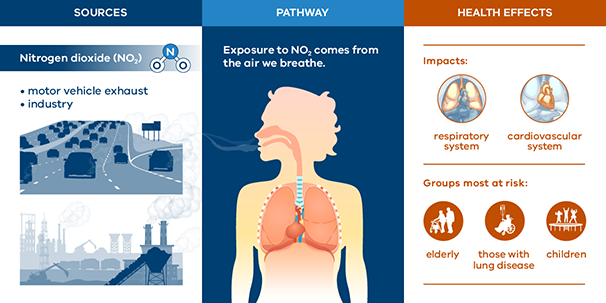Nitrogen dioxide (NO2) is a gas. Breathing it in can irritate your throat and lungs.
Nitrogen dioxide is a common air pollutant. In Victoria, nitrogen dioxide levels are usually low. We measure nitrogen dioxide at some of our air monitoring sites.
Sources of nitrogen dioxide
The main sources of nitrogen dioxide in Victoria include:
- car and truck exhausts
- coal-fired power stations
- industry.
Health effects of nitrogen dioxide
Breathing in high levels of nitrogen dioxide can affect your health. You’re more likely to have symptoms if you:
- are sensitive to air pollution
- have a lung condition like asthma.
Symptoms can include wheezing, coughing and shortness of breath.

Nitrogen dioxide on EPA AirWatch
We show nitrogen dioxide data on EPA AirWatch using air quality categories.
| Air quality category | Nitrogen dioxide averaged over 1 hour (parts per billion) |
|---|---|
| Good | Less than 60 |
| Fair | 60–120 |
| Poor | 120–180 |
| Very poor | 180–360 |
| Extremely poor | More than 360 |
Current standards for nitrogen dioxide
| National standard in parts per million (and parts per billion) | Averaging time |
|---|---|
| 0.08 ppm (80 ppb) | 1 hours |
| 0.015 ppm (15 ppb) | Annual |
Read more about air quality
Vehicle emissions and air quality
Reviewed 30 March 2022



